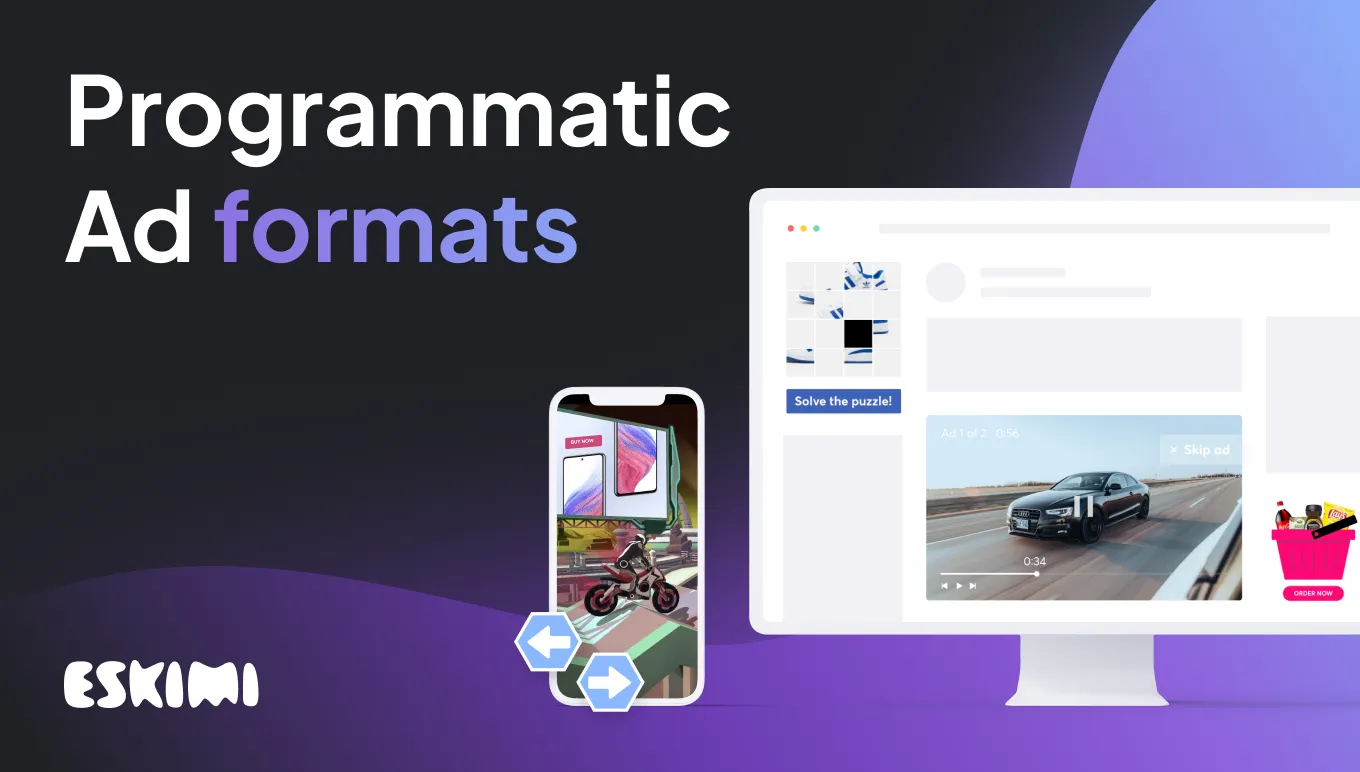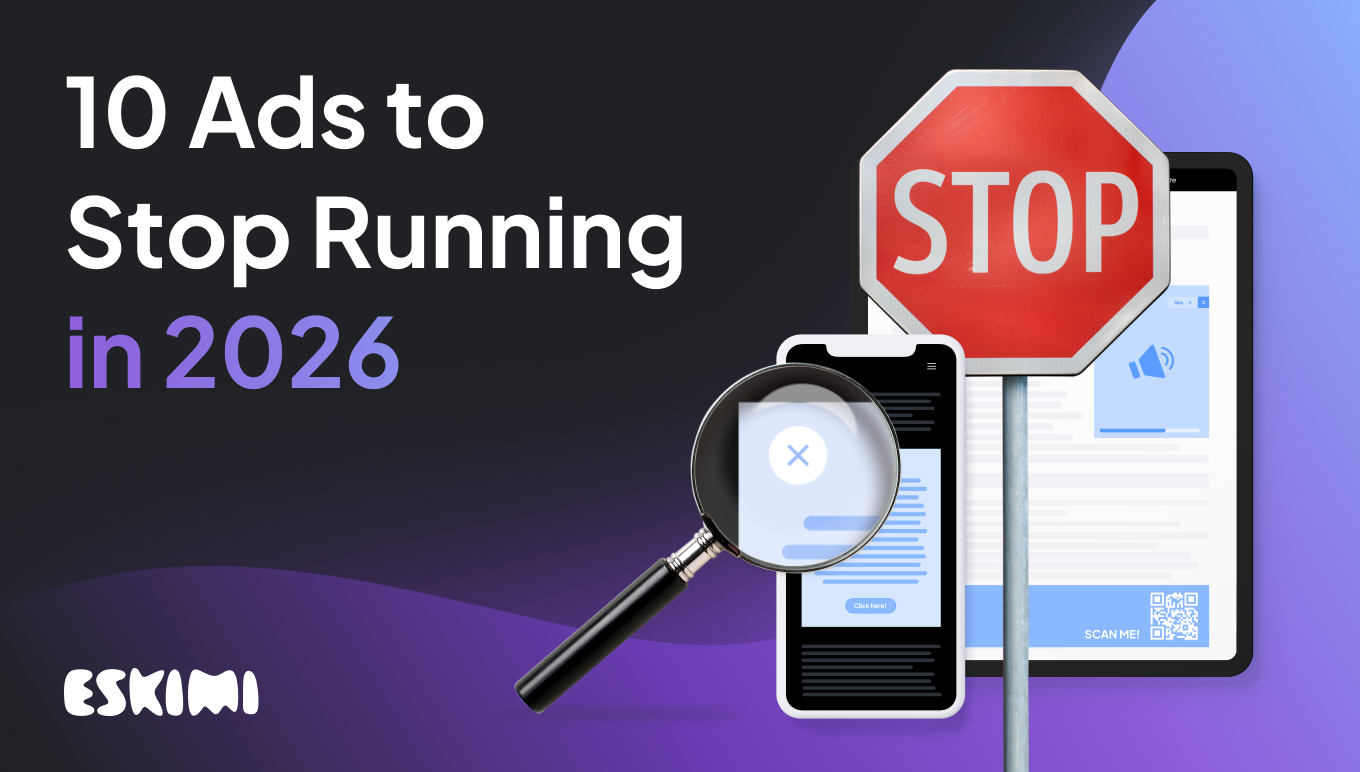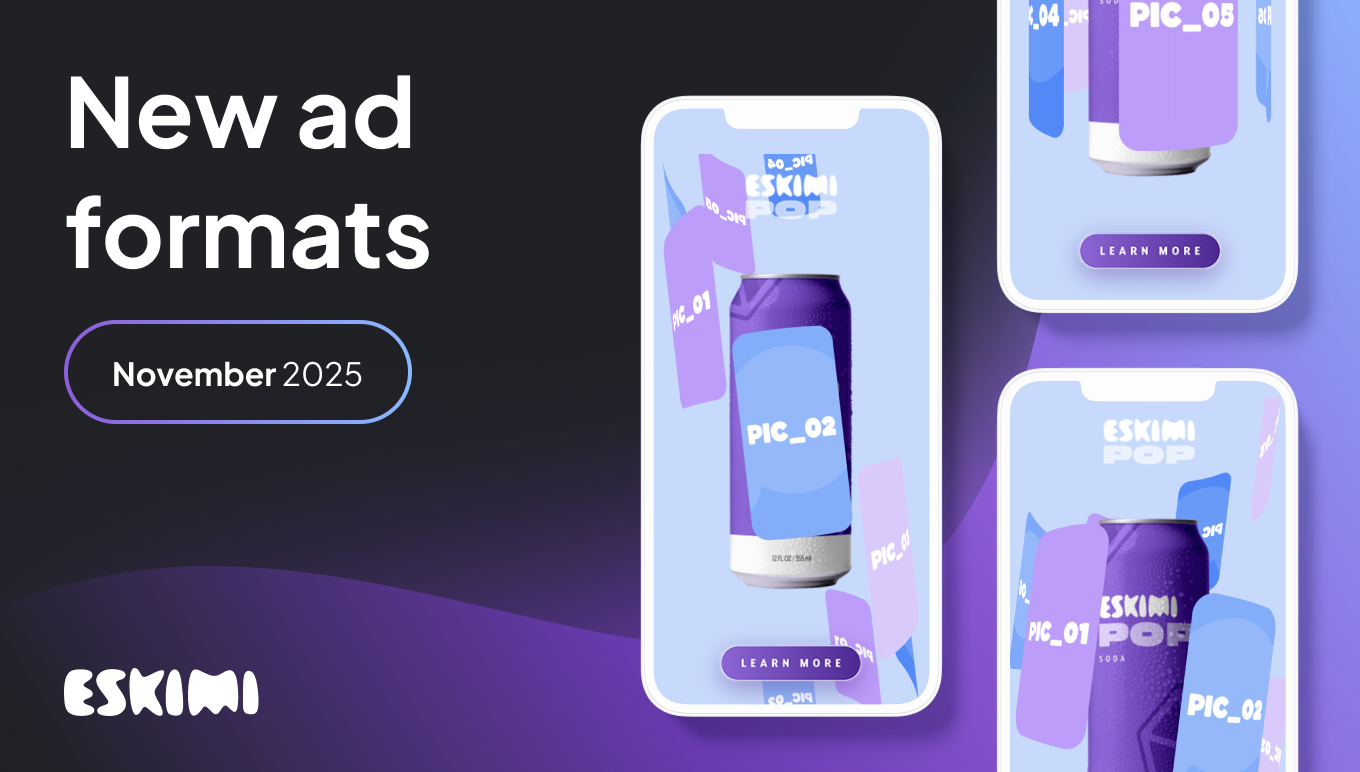Programmatic Ad Formats: Maximizing Campaign Effectiveness

Of all digital advertising types, programmatic is among those providing brands with the most room for creativity.
In a world of short attention spans, marketing noise, and ever-growing online content consumption, advertisers have no choice but to employ innovative ad solutions to capture user interest.
Programmatic can help them do exactly that as it offers a range of ad formats that any brand can choose based on their advertising goals and adjust to the needs of their target audience.
In this post, we’ll look at various programmatic ad formats and learn how choosing the right one can help boost campaign results and achieve your advertising goals.
What is programmatic advertising?
Programmatic advertising is a digital advertising technique that allows advertisers and publishers to buy and sell ad inventory in-real time through software platforms, like DSP and SSP.

As opposed to more traditional forms of advertising dominated by manual buying and negotiations, programmatic uses algorithms and data to buy/sell ad placements, often through a real-time bidding process. The highest bidder earns the right to display their ad to their target audience.
Using programmatic, advertisers can target their audiences based on various targeting criteria, such as demographics, interests, location, and more. It also allows them to deliver their messages to people across multiple advertising channels, including more traditional ones like display, and emerging channels such as in-game and CTV.
Importance of selecting the right ad format
The ad format that you choose can make a huge impact on your ad campaign performance and results. Users see hundreds, if not thousands of ads every single day, so your goal is to stand out from the crowd and ensure that they interact with your creatives instead of your competitor's ads.
- Audience engagement. First and foremost, choosing the right ad format can help capture the audience's attention and engage them better. For example, compared with static images, video ads tend to have better engagement rates as they can provide more information and tell a story.
- Impact on branding. The right ad format can help strengthen branding efforts by creating a lasting impression. If you need more space for images, branding elements, logos, and text, not all ad types can let you fit everything and do it nicely, so it’s crucial to think of your idea and vision before choosing the creative type.
- Ad placements. Different ad types and formats work better in different ad placements; therefore, knowing where you want your ads to appear and keeping this in mind can positively impact your campaign results.
- Targeting. Different ad formats may better suit different target audiences (e.g., younger audiences might respond better to rich media gamification ads than basic static images).
- Performance. The right ad format can improve the campaign’s performance metrics, such as click-through rate (CTR) or conversion rate.
So before bringing any creative to life, think of what purpose it needs to fulfill and what can help your campaign succeed. Consider your goals, target audience, the impact you want to make on your potential customers, and go through the list below to identify the best programmatic ad formats for your next campaign.
Common programmatic ad formats
Display ads
Display ads are probably the broadest term used to define nearly any visual ad appearing on websites, social media platforms, mobile apps, and other digital channels.
In programmatic, display advertising mostly refers to ads you can see in the header, footer, or sidebar placements. They often appear in the form of static images, videos, or interactive multimedia content and are designed to grab the attention of potential customers and encourage them to take action.
You can use various targeting criteria for display ads, including demographics, behavior and interests, location, etc., and can be purchased through various advertising platforms.
Below are some examples of different display ad types, some of which you might not even be aware of (although you should be).
Static and animated ads
Advertisers commonly use static display ads to spread the word about their products and services. These ads can appear in various sizes and shapes, like square banners or leaderboard ads.
Animated display ads feature some animation to capture the viewer’s attention (moving images, transitions, other elements), and can be served as GIFs, videos, or HTML5 ads.

Rich media
Rich media ads are digital ads that contain advanced elements and features designed to boost customer engagement with the ad content.
By serving rich media ads, advertisers allow their audiences to interact with ads by touching, swiping, dragging, scratching, spinning, playing a game, and more.
Put simply, rich media offers a wider variety of interaction possibilities that make ads more attractive to target audiences.
Sticky ads
Sticky ads are digital ads that stay visible or stick on the page while the user scrolls through the content.
Most often, you’ll be able to see them as horizontal or vertical, although there can also be a variation of both.
When advertising online, sticky ads can be a great way to increase ad visibility and fight banner blindness, as they can reduce the chances that the user will just scroll past the ad and doesn’t notice it.

Dynamic ads
Dynamic ads are powerful ads that can automatically change content based on chosen criteria and API integrations. This way, advertisers can increase ad relevancy.
For instance:
- Weather ads enable promotions of relevant products based on weather conditions in specific locations. E.g., if it’s raining in New York, local users might be able to see ads for umbrellas or raincoats.
- Live score ads provide real-time results for various sports games.
- Product feed ads can display up to 20 products based on information such as product descriptions, images, prices, etc.

Floating ads
Floating ads are another programmatic ad format that, as the title suggests, floats on top of the content and stays in a fixed position on the page while scrolling. They can appear as images or videos, and users can easily close such ads by clicking a close button.
Floating ads are created to maximize visibility, therefore, help boost brand awareness and brand recall. It’s also easier to capture user attention using floating ads and encourage engagement with the creative.

Calculator ads
Calculator ads are exactly what they sound like – calculators and estimators that are included in ad creatives.
They can work based on the provided data and help to improve user engagement.

Data collection banners
Similar to calculator ads, data collection banners invite users to fill in some fields in the ad creative.
For advertisers, this programmatic ad format can help collect the answers they need for lead generation, a better understanding of user behavior, opinions, etc., directly from the ad creative.

High Impact ads
High Impact ads are creatives that take interaction to a whole new level. These ads are known for their non-standard solutions, are designed to effectively capture users’ attention, and leave a lasting impression.
Typically, High Impact ads are difficult to ignore (floating ads, screen takeovers – anything that makes it difficult to just scroll past without noticing it) and often allow the audience to change their content in one way or another.
For instance, see the Avis ad below. Users visiting specific sites could see a tiny red car moving on their screens. Successfully "catching" the car resulted in an Avis video taking over the screen while clicking anywhere on the ad brought visitors to the landing page.
Native ads
Native ads are digital ads that seamlessly blend in with the website, making them look and feel like they are a natural part of the content where they are displayed.
The goal of this advertising type is to create less intrusive and more engaging ads that can help provide a better user experience. Since they’re integrated into the content users are already consuming, native ads are also more difficult to skip or ignore.

Video ads
Video ads can be displayed on various platforms and channels, like in-game or CTV, and are one of the most engaging and attention-grabbing forms of digital advertising.
Video ads are considered to be an effective way to reach a wide audience and can work with a variety of targeting options. As video consumption continues to grow, more advertisers are taking advantage of this digital ad type.
Videos can also be outstream (served outside of traditional video players) and instream (interrupt ongoing video content).
A couple of the most commonly used video ad types include:
- VAST video – it’s a video served on the publisher’s page in a video player.
- IBV – an HTML5 banner that takes up regular banner placements and follows standard banner sizes.
- Rich media with video allows showing static or rich media banners using video format.

Click-to-action ads
Click-to-action ads are a unique programmatic ad format that is very straightforward and calls users to act – whether to click on the website link, map, send an SMS, call, etc.
Put simply, instead of bringing users to some landing page, it allows them to perform one of the mentioned actions.
Click-to-action ads are not a separate format; they can appear like static, floating, or rich media ads; the difference lies in ad settings.

Audio ads
Programmatic audio ads can be delivered to listeners of streaming audio content, like music streaming services, podcasts, online radio, and similar, as well as video gamers.
They are bought and sold the same way as other programmatic ads, often based on bidding on ad inventory in real-time. Targeting doesn’t differ that much from regular display ads, yet you can expect to be able to target by audio-specific options like music genre.
With audio ads, advertisers can deliver personalized messages to highly engaged audiences and do it in a less intrusive way.
Blended in-game ads
Blended in-game advertising is the practice of buying ad placements in video games that seamlessly blend with the game environment and become a part of the gaming experience.
For game developers, it’s a chance to boost their game revenue, while advertisers get to reach diverse and highly engaged audiences, putting their experience first.
In-game ads can be created in two formats, display (JPG, GIF, standard rich media) or video (VAST).

CTV ads
CTV advertising is a practice of delivering targeted ads to people who watch streaming content using internet-connected devices like smart TVs, gaming consoles, or streaming boxes/sticks (Roku, Chromecast, etc.).
As the number of CTV households keeps increasing, advertisers use CTV ads as an effective way to reach cord-cutters. They can be served in multiple formats, like instream video ads (pre-roll, mid-roll, post-roll), interactive video ads, or display ads.
Some of the biggest CTV ad benefits include better control of who sees your ads, reaching engaged viewers where they are, and being able to measure the campaign results and get valuable insights as it includes all standard and video metrics, like impressions, reach, first quartile, midpoint, third quartile, complete, VTR, CPV, views, and so on.

DOOH ads
DOOH, or Digital Out-Of-Home, is a programmatic ad type that allows serving ads using digital screens, such as billboards, digital signage, and other displays, in public places like airports, train stations, malls, health care institutions, etc.
Using DOOH advertising, brands can reach people outside their homes and on the go, which is also one of the ways to drive foot traffic to physical locations.

What makes a good ad creative?
Whichever programmatic ad format you decide it’s best for your next campaign, great ads often share a few key aspects that… make them great.
So before launching your next programmatic campaign, ask yourself:
- Does your ad capture attention? You can do it with a clever headline, eye-catching image or video, or creative design.
- Is your brand name clearly visible/recognizable? You want people to remember you next time they’re ready to make purchase decisions.
- Will my ad look good on different devices? Is it mobile-friendly?
- Does my ad address customer pain points? Is it clear why customers need the product, how to use it, or how it will solve their problems?
- Is the copy of your ad compelling and well-written? Error-free?
- Is your ad relevant to your target audience, their needs and interests?
- Is it clear and straight to the point? You don’t have much time to convince your potential customers to take action.
- How about an emotional appeal? Does your ad evoke emotions like joy, fear, or any other that resonates with your audience?
- Does your ad have an encouraging call to action? People will be more likely to act on your offers if you tell them what you expect them to do next.
What format will you choose for your next ad campaign?
Programmatic advertising is becoming a go-to tactic for advertisers who want to serve their ads in a more efficient and effective way. Besides such important things as ad targeting and the content itself, choosing the right programmatic ad format is crucial to achieving your campaign goals.
By understanding how each ad format can help bring the desired results, brands can start tailoring their ads for the best performance on specific channels, ensuring their ad creatives are displayed how they were meant to be displayed.
Need help to decide? Contact the Eskimi team or book a demo for a smooth start.
Level Up Your Advertising with Eskimi
- Reach 96% of Open Web
- 2,500+ Targeting Options
- 100% Managed or Self-Service
- In-House Creative Studio Team
- Display, Video, In-Game & CTV
- #1 Rated DSP on G2




.png)